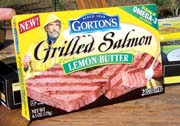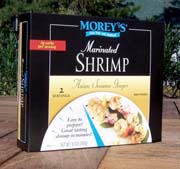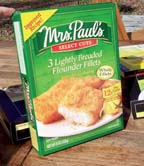
Positives abound for the seafood industry, including the fare's healthful perception. With more consumers embracing the health and wellness trend (be it through low-carbohydrate dieting or other, perhaps more-enduring regimens), manufacturers and marketers wisely are reassuring consumers that fish and seafood are among the healthier meal options available. Nonetheless, growth in the segment will require continued efforts to communicate the proper purchase and preparation of fish and seafood products.
Whether low-carbohydrate dieting has staying power need not be a concern to the segment's manufacturers. For consumers on such diets, protein sources such as fish and seafood are a viable alternative to red meat and poultry. Should those diets fade, the segment will benefit from the healthful positioning inherent in many of its products; salmon, for example, has been well-cited as a source of heart-healthy omega-3 fatty acids.

Wilding
The market is not without its hazards, however. The mainstream media has been quick to note safety concerns about mercury levels in canned tuna, not to mention polychlorinated biphenyls (PCBs) in farm-raised salmon. According to a study in the journal Science, more than a meal of farm-raised salmon a month could increase slightly the chances of getting cancer later in life. Apparently, the problems center around feed pellets made from contaminated fish; however, salmon concerns are not limited to those from the farm. The segment also faces negative press from a more-ecological slant, in the form of dangers from overfishing and detrimental effects on the environment.Long a staple in the homes of many consumers, shelf-stable or canned foods have enjoyed a resurgence in recent years, buoyed by new types of packaging that help make fish a convenient meal or snack. Tuna, in particular, has benefited from pouch packaging, but its sales have suffered in the wake of mercury concerns. An effort to reassure consumers of the benefits of eating canned tuna saw competitors StarKist (H.J. Heinz, Pittsburgh), Bumble Bee (Connors Bros. Income Fund, Blacks Harbour, N.B.) and Chicken of the Sea (San Diego) collaborate in a joint campaign. Of course, each also continued with its own advertising efforts, but the joint campaign does serve to indicate just how seriously the segment's companies regard the potential threat.
Mintel (Chicago) finds the amounts of positive and negative health information are roughly equal and boil down to fish's health benefits versus safety issues.
Those healthful attributes are notable. Beyond the benefits of omega-3 fatty acids in salmon, tuna, et al., the fish also have a high protein content and low levels of saturated fat. These features prompted the American Heart Association (Dallas) to recommend people in good health and those at risk of cardiovascular disease eat fish at least two times per week. Furthermore, a 2004 study at the Brigham and Women's Hospital and Harvard Medical Center (Boston) found that eating fish can reduce the risk of irregular heartbeats.
That positive, however, masks a negative when evaluating fish's position relative to other protein sources. Mintel's consumer research finds that 28% of respondents regard fish and seafood as most likely to be tainted, relative to other meats, including red meat and turkey. In addition, some 15% said that mercury levels in fish have prompted them to reduce the amount of fish consumed. On the other hand, 42% have increased consumption to take advantage of the health benefits of these products.
Is it any wonder consumers are confused? The valid positives and negatives aside, the consumer also faces misinformation (be it through mislabeling, relabeling or misdirection) that leaves him bombarded with information. Ultimately, Mintel finds consumers face two options: “Either forego eating fish and seafood that has a hint of uncertainty or controversy, or take their chances.”
Feigning Fresh
Those willing to take the risk have benefited from seafood's improved packaging. The pouch has improved tuna's portability and status as a lunchtime option, but it has not been the sole driver. To promote the freshness of its products, TruFresh (Suffeld, Conn.) promotes its Norwegian Atlantic salmon on the basis that it is three days old when frozen, while other companies have opted for vacuum-packed sealing methods to improve freshness.Convenience takes many forms in this segment: it can be as simple as packaged items (thus preventing the need to stop by the fish counter), varying portion sizes, heat-and-serve entrées with stuffed cod and crab-stuffed fish or lobster, or pre-formed crab cakes and ready-to-serve chowder and bisque.
Pre-prepared also has attracted consumers. Morey's Seafood International (Minneapolis), for example, offers a line of packaged, marinated salmon in six varieties. Helping to alleviate some possible concerns about the proper cooking time, the filets feature a pop-up timer. This seems particularly helpful when realizing that many consumers are uncertain about how to prepare fish, and that many of them perceive the items as pricy products with which to experiment.
Generally, fish and seafood are more expensive than equivalent amounts of beef or poultry, the latter a much more economical choice, according to 63% of Mintel's respondents. Fish and seafood, on the other hand, are regarded as the best value by 11%. While the various cuts and grades of beef offer a variety of price points, consumers do not find as many options in seafood, shrimp being somewhat the exception. Increased supply has resulted in a dip in shrimp prices--and a corresponding increase in the segment's sales.
Sales of fish and seafood are growing at a healthy 7.5%, in constant prices, although that is more than double the growth rate of 2003, which itself improved upon a negatively performing 2002, in constant 2004 prices. That resurgence in 2003 flowed from the low-carb trend and healthful benefits mentioned in the press, assesses Mintel.

Getting Fresh
Sales of fresh fish have grown 11% since 1999, as increased sales of shrimp surpassed those of tuna for the first time in 2001. Salmon, pollock and catfish round out the top five. Price increases in 2003 and 2004 have stemmed from the positive health news surrounding fish, and sales of salmon in particular have “skyrocketed,” reports Mintel. Furthermore, even increased supply is not keeping pace with consumer demand.The frozen fish and seafood segment, as defined by Mintel, includes frozen shrimp and fish filets, and breaded versions of those items. The popularity of shrimp has led to a 22% increase in segment sales (constant prices) in 2004--and a 62% growth since 1999. Shrimp has benefited from a number of developments over that time. It is available at a variety of different price points and accessible to consumers at different economic levels; it can be purchased in bulk and kept in the freezer; and the segment is dominated by private label.
Sales of breaded types of frozen fish and seafood have benefited from manufacturer innovation in recent years. Fish bites and products designed to be eaten on-the-go have proven successful, as have flavored breaded shrimp items. Those latter products, traditionally sold to foodservice, have found their way into retail environs.
More recently, tuna has experienced flat sales, but the segment is projected to increase 8.6% in constant 2004 prices. The pouch concept certainly has helped, but the segment also has prospered from pre-marinated items, such as StarKist's Tuna Creations. A July lawsuit against StarKist, Bumble Bee and Chicken of the Sea dealt the segment a public relations blow. The suit claims packaged tuna from the three exceeds the level of methylmercury needed to require exposure warnings.
The canned segment includes fish types other than solely tuna, but their sales are much less. Bumble Bee's canned salmon had $36 million in sales in 2004; canned tuna netted over $327 million. Other canned items, such as sardines, are considered much less user-friendly than tuna, suggests Mintel.
Sales of refrigerated seafood grew 15.9% in 2004 and 36% since 1999, fueled in part by new products “catering to consumers' desire for innovative meal options,” Mintel asserts. Marinated seafood and partially prepared products (stuffed fish and lobster, for example) are answering the convenience call. Furthermore, the products in this segment are less expensive than their counterparts and quite versatile.
Considering the room for growth in consumption levels, fish and seafood sales could have a bright future, if the segment's companies can take advantage of the positive news surrounding it. Mintel believes sales will grow 21% at constant prices between 2004 and 2009, led by strong increases in sales of frozen (53%) and refrigerated fish (36%). The other two segments, fresh and canned, should grow 17% and 15%, respectively, believes Mintel.
For more information on the report mentioned in this article, “Fish and Seafood,” contact Mintel International Group Ltd.; 351 W. Hubbard, Suite 800; Chicago, IL 60610; phone: 312-932-0400.
